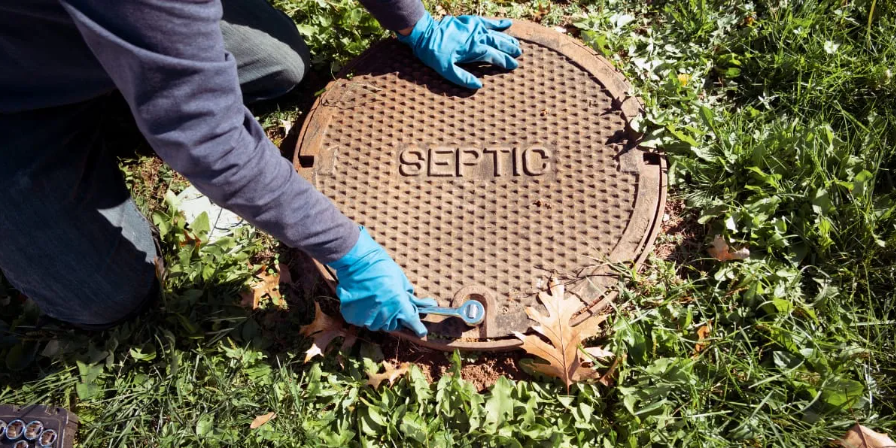Maintaining a septic tank is essential to ensure it functions properly and efficiently. Neglecting regular care can lead to a range of issues, from clogged pipes to unpleasant odors and expensive repairs. Whether you’re a first-time homeowner or someone looking to refresh your knowledge, understanding septic tank maintenance is crucial to avoid these problems and ensure the longevity of your septic system.
What is a Septic Tank?
A septic tank is an underground wastewater treatment system used to process household waste in areas where municipal sewer systems are not available. The tank typically consists of a large, watertight container made of concrete, fiberglass, or plastic, which collects and holds wastewater from your home. As the waste enters the tank, the solids settle at the bottom, forming sludge, while the liquid effluent (or wastewater) rises to the top and flows out to a drain field for further filtration.
The septic system functions through the natural processes of settling, bacterial digestion, and filtration. If your septic system is not maintained, however, the process can be interrupted, leading to significant issues such as overflows, backups, or even environmental contamination.
Why Septic Tank Maintenance is Important
Proper septic tank maintenance is critical for several reasons:
- Avoid Costly Repairs: Septic systems that are neglected can become expensive to repair. Regular maintenance helps identify minor issues before they escalate into major, costly problems.
- Prevent Sewage Backups: If your septic tank becomes too full or clogged, wastewater can back up into your home, leading to messy, unsanitary conditions that are both unpleasant and expensive to clean up.
- Protect the Environment: A malfunctioning septic tank can leak untreated waste into the surrounding environment, which can contaminate local water sources and harm local wildlife. Proper maintenance ensures your system operates efficiently and protects the environment.
How to Maintain Your Septic Tank
Maintaining a septic tank requires a few basic steps to ensure it functions properly. Below are the key tasks for septic system maintenance.
1. Pump Your Septic Tank Regularly
One of the most essential steps in septic tank maintenance is having your tank pumped on a regular basis. Over time, solids accumulate in the tank and must be removed to prevent the system from becoming overwhelmed. The tank should typically be pumped every 3 to 5 years, although this can vary depending on the size of the tank and the number of people in the household.
2. Monitor Water Usage
Excessive water usage can put unnecessary stress on your septic system, potentially leading to malfunction. It’s important to be mindful of how much water you use and how quickly it is used. When too much water enters the system at once, the solids in the tank may not settle properly, and the wastewater may not be filtered effectively.
Consider installing water-saving fixtures such as low-flow toilets, showerheads, and faucets to reduce water consumption. Additionally, avoid running large loads of laundry or dishwashing all at once. Spread out your water usage throughout the day to prevent overloading the system.
3. Be Careful What You Flush
What you flush down the toilet plays a significant role in the health of your septic system. Only toilet paper and human waste should be flushed. Many items commonly flushed down toilets, such as paper towels, wipes (even those labeled “flushable”), feminine hygiene products, and grease, do not break down easily in a septic tank. These materials can cause clogs and lead to system failure.
It’s also advisable to avoid pouring cooking oil or grease down the drain, as it can solidify in the pipes and tank, creating blockages. Educating your household about what can and can’t be flushed will help maintain the health of your septic system.
4. Maintain Your Drain Field
Your septic tank’s drain field is crucial for filtering out contaminants from the effluent before it enters the ground. To protect your drain field and ensure it functions properly, it’s important to avoid certain practices that could cause damage:
- Avoid planting trees or shrubs near the drain field: The roots of plants can infiltrate the system and cause blockages or pipe damage. Stick to shallow-rooted grass in this area to avoid complications.
- Don’t drive over the drain field: The soil over the drain field should remain loose and absorbent. Driving over it with heavy vehicles or equipment can compact the soil and prevent proper filtration.
- Keep it clean and clear: Ensure that no debris or waste accumulates on the drain field. This could clog the soil and prevent it from functioning properly.
5. Install an Effluent Filter
Consider installing an effluent filter at the outlet of your septic tank. This filter helps catch large solids that might escape from the tank and enter the drain field, preventing blockages in the pipes. By installing an effluent filter, you’ll significantly reduce the risk of clogs in your system and extend its lifespan. Make sure to have the filter cleaned regularly to maintain its efficiency.
6. Avoid Chemical Drain Cleaners
Chemical drain cleaners can damage your septic system. These harsh chemicals can kill the beneficial bacteria that break down waste in the tank, leading to a slower process of waste decomposition. While it may be tempting to use these cleaners to clear clogs, it’s safer to use natural alternatives or call a professional plumber to address the issue.
7. Schedule Routine Inspections
Routine septic tank inspections are a crucial part of maintaining your system. During an inspection, a professional technician will check for signs of damage or malfunction, such as leaks, cracks, or blockages. They will also assess the overall health of the septic system, checking the sludge and scum levels and determining whether pumping is necessary.
Regular inspections can help identify small issues before they become big, costly problems. It’s best to have your septic system inspected at least once a year to catch any potential issues early.
Signs Your Septic Tank Needs Attention
In some cases, issues with your septic tank may not be immediately apparent. However, there are certain warning signs that indicate your system may require attention. Look out for the following:
- Slow Drains: If your sinks, showers, and toilets are draining slowly, it could be a sign of a clogged or full septic tank.
- Foul Odors: Strong, unpleasant smells around your septic tank or drain field could indicate a problem with the system.
- Pooling Water: If you notice pooling water or soggy areas around the drain field, it could be a sign of a malfunctioning septic tank.
- Sewage Backups: A backup of sewage in your home is a clear indicator that your septic tank is either full, damaged, or not working properly. Immediate attention is required to prevent further damage.
Conclusion
Proper septic tank maintenance is essential for preventing costly repairs, protecting the environment, and ensuring your system runs smoothly for years to come. Regular pumping, careful monitoring of water usage, and avoiding harmful substances will help extend the lifespan of your septic system. Additionally, scheduling routine inspections and maintaining your drain field will ensure everything continues to function as it should.






